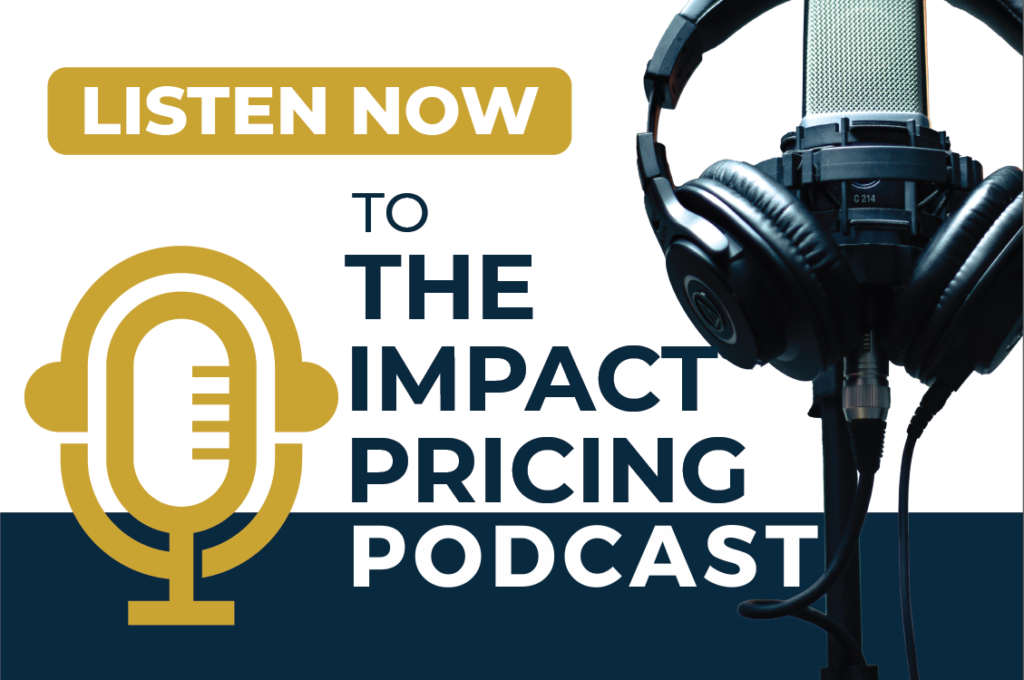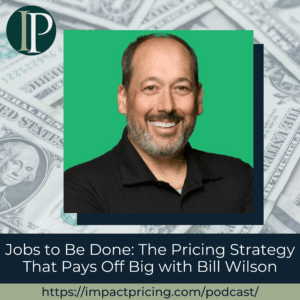Vladyslav Podoliako is the founder and CEO of Belkins.io, a leading B2B appointment setting agency, and Folderly, an email deliverability system. With a strong entrepreneurial spirit and a focus on performance-based results, Vlad has successfully navigated the complexities of pricing in the B2B space. He is passionate about helping companies scale their businesses through effective client acquisition strategies.
In this episode, Vlad shares his journey from launching Belkins to evolving his pricing strategies as the company grew. Together, they explore the critical role of pricing in business growth, the importance of aligning pricing with customer value, and the unique challenges of pricing in the B2B landscape.
Podcast: Play in new window | Download
Why you have to check out today’s podcast:
- Understand the significance of aligning pricing with customer value and performance.
- Discover the importance of testing pricing strategies and gathering client feedback.
- Explore the psychological aspects of pricing and how they influence customer decisions.
“Pricing is like blood in the veins for a growing company. You should have a great pricing model that is scalable and profitable.”
– Vlad Podoliako
Topics Covered:
01:10 – Vlad introduces himself and discusses the common misinterpretation of his company names.
02:15 – The importance of pricing in Vlad’s entrepreneurial journey and how it evolved over time.
04:36 – Overview of Belkins and its approach to client acquisition.
06:51 – Discussion on the pricing model based on sales qualified leads (SQLs) and its correlation with client ROI.
09:32 – Insights into product packaging and the pricing strategy for Folderly.
13:15 – The impact of high pricing on customer expectations and delivery pressure.
15:42 – The psychological aspects of pricing and how they relate to perceived value.
19:41 – Discussion on the entrepreneurial spirit in Ukraine and its impact on business success.
24:21 – In scaling your company, how often should you revisit your pricing?
26:50 – Vlad’s advice on being courageous with pricing and testing strategies.
28:01 – Thoughts on ChatGPT pricing for pro.
30:01 – Connect with Vlad.
Key Takeaways:
“Be courageous about your pricing. Test it out more than you strategize theoretically.” – Vlad Podoliako
“(on pricing) It’s about how much tries you do before you succeed and how resilient you do that. All of these events, historically, we kind of have this in our blood, adaptability, resilience, and hard work.” – Vlad Podoliako
People/Resources Mentioned:
- Belkins: https://belkins.io/
- Folderly: https://folderly.com/
- OpenAI: https://openai.com/
- Sam Altman: https://en.wikipedia.org/wiki/Sam_Altman
- NVIDIA: https://www.nvidia.com/en-us/
- Google: https://www.google.com/
- LinkedIn: https://www.linkedin.com/
Connect with Vladyslav Podoliako:
- LinkedIn: https://www.linkedin.com/in/chiefdata/
- Email: [email protected]
Connect with Mark Stiving:
- LinkedIn: https://www.linkedin.com/in/stiving/
- Email: [email protected]
Full Interview Transcript
(Note: This transcript was created with an AI transcription service. Please forgive any transcription or grammatical errors. We probably sounded better in real life.)
Vlad Podoliako
Be courageous about your pricing. Try to test it out more than strategizing on that and theoretically building this. Because you can always jump on the call with your clients and try to test your pricing or whatever hypothesis that you have for the pricing.
[Intro / Ad]
Mark Stiving
Welcome to Impact Pricing, the podcast where we discuss pricing, value, and the growth-oriented relationship between them. I’m Mark Stiving, and I run boot camps to help companies get paid more. Our guest today is Vlad Vlad Podoliako. Oh my God, I just practiced that and I messed it up.
Vlad Podoliako
You did it amazing. You did it amazing. Thank you for having me, Mark.
Mark Stiving
Here are three things you want to know about Vlad before we start. He is the founder and CEO of Belkins.io, probably not the Belkin you and I know.
He’s the founder and CEO of Folderly, and he’s an investor, invests in a lot of different companies.
Welcome, Vlad.
Vlad Podoliako
Thank you, Mark. Thank you for intro.
And you know, like Belkin and Belkins is common, like not miscommunication, but misinterpretation of brand.
And sometimes through our sales calls that we have, and we are a B2B appointment setting agency, the best in the market. We were getting some calls that guys like, are you selling iPhone? We’re like, “Hey, why are you even saying this?”
Yeah. And that’s crazy. After eight years, imagine we are eight years on the market and sometimes people like randomly passing by and asking me if I can sell them the wire for iPhone.
Mark Stiving
That’s crazy.
So on your homepage, it needs to say, we are not the iPhone accessory company.
Vlad Podoliako
Oh yeah. But that’s a long story why it’s Belkins. Yeah.
Mark Stiving
I always start the conversation out with how did you get into pricing?
And I know you’re not in pricing. You’re really an entrepreneur, a founder, but I’m sure that pricing is important to you. And you and I’ve actually talked about it a little bit in the past.
So what do you think of pricing? How did you get into it? How did you realize it was such a crucial topic?
Vlad Podoliako
Yeah, since like we started our Belkins eight years ago, as I said before, and we started like very simple. We saw how companies like in our space, other agencies price their services, like going with a subscription, like monthly subscription.
Retainer was like upfront payments, not payments and with some sort of like currencies, no guarantees, et cetera. And we just like, basically I would say copy that because it already working and customers already familiar with it.
But since we are starting to grow and over like a year building a company, having 300 people, we’re starting to evolve our product offerings evolve a lot. from day one and our ideal customer profile, while we pivot to from small and medium sized businesses to enterprise and a more up market.
And actually, like when we spoke last time, I explored like what we can do to meet the need for like this bigger folds, bigger enterprise, the Fortune 500 companies and how they like even perspective pricing, how they look at that.
And I realized that it’s very important topic. And that we need to meet them, not just in market, but the feelings of our clients and more like kind of another level right now. And pricing is like blood in the veins for the growing company.
You should have a great pricing. It should be scalable. It should be profitable and a lot from that.
So this is why we spend nowadays, like months before like creating or publishing and releasing some prices for other product, other companies. But that’s critical nowadays.
Mark Stiving
Yeah. So when I think of pricing, I think of many, many different topics and I think you touched on several of them. Let me just ask you about a topic and then, and then you can riff on it a little bit and say, “Hey, this is how we think about it.” Yeah.
One of the things you brought up already was something I’ll call a pricing metric, right? So the pricing metric is what do we charge for? And you said, “Hey, when we first launched, we were doing it per user like everybody else does. And, and so how did you go about saying, here’s the pricing metric that makes sense.
And by the way, tell everybody what Belkins actually does, because maybe that’ll give us a little more guidance into,or insight into your thinking.
Vlad Podoliako
Yeah. Yeah. Happy to. So a Belkins is to be acquisition agency. We positioning ourselves as a acquisition partner, working to help our clients to get more clients, to scale their businesses, to scale their products or help them to make the right people for certain audiences.
And we using different channels for that. We started with email acquisition channel, and now we are. doing kind of omni-channel work.
Now it’s really, I would say, comprehend to build your acquisition with only one acquisition channel, like email, like were 10 years ago. And now you need to do cold calls, email, ads, CEO, content and everything.
And yeah, so that’s about Belkins. And we, as I said, we charging our clients on retainer model. So basically we have contract that we’re signing was our clients, not kind of per user basis, but per company basis, I would say.
And we came up with that kind of pricing because it more kind of I would be a super straightforward and simple about that. It just makes sense for the model, how we charge and how we build it, our business model, like a hundred percent connected to the business model that we have.
So pricing affect the business model. I mean that. in our hearts, in Belkins heart, we are performance based for our clients.
So meaning that people getting bonuses, total compensation when they hit certain targets for our clients, meaning clients pay for that.
So we have like strong correlation with the client’s KPIs and pricing alongside where the compensation for our performance for our delivery teams.
So this is why this current pricing model more meet the need of the business revenue model. It does make sense.
Mark Stiving
I was going to say, so are you pricing based on growth? So I get the retainer piece, but that still doesn’t say when you get your chunk of the retainer, unless it’s just a subscription and you get it every month, no matter what.
But are you pricing based on how much revenue growth we achieve?
Or are you pricing based on the number of new leads we generate? How are you pricing?
Vlad Podoliako
Correct. Correct. On the number of the new lead that we are generating for our clients. And we call it SQL, sales qualified lead.
And based on that, our clients can justify if this investment worth a shot and how they can get an ROI from that.
Like, for example, we’re promising 100, 200, 500 SQLs per year, meaning that we are on average scheduling like 20, 40 meetings per month when we’ve got to the ramp up period, when we know that there’s the right value proposition, that the good positioning for the company, there is the product market fit, and we can scale things up.
And clients basically using simple math, What is their close rate? What is their sales cycle? It’s usually three, six, 12 months, depending on the size of the company that you’re working with and dividing by the number of meetings that they getting with us.
And they can justify ROI of the business model. So for example, we’re charging them like 10 grand a month and which is 120K per year, meaning that we need to bring them at least like our internal metric that we need to bring at least three multiples from that, like on average, 300,000, 500,000 annually to justify the investment, because they have also their own internal costs, salespeople, team delivery, etc, etc.
Mark Stiving
Yeah, so one of the things that’s great about your business is that you can point directly to revenue.
You could say, these are revenues that we brought in for you or we found for you. You had to do the clothes, but we brought it in.
Vlad Podoliako
And think about it.
Mark Stiving
Yeah. It’s always nice when you can tie what you do directly to the revenue that a customer is going to make because of what you did it because of what you did.
Vlad Podoliako
So that’s true. That’s true.
Mark Stiving
I often say the phrase buyers trade money for value.
And in B2B value is measured in incremental profit. And so how much more money did you make me? And so you, you’re in a great position to say, here’s how much more money we made you.
Vlad Podoliako
Yeah. Or save time or optimize something or automate something because CEOs, founders, and in general businesses fighting for their margins, especially right now when you like, we’re basically, we’re living in an economy stability is the most soft way to say that.
Mark Stiving
Yes. Very unstable at the moment. Okay.
So next topic I want to, I want you to riff on a little bit that has to do with pricing in my head, and that is product packaging. So how do we think about what we offer? I love good, better, best when we can pull it off when it, when it makes sense.
So how do you think about that?
Vlad Podoliako
I can actually start with an example. So one of our first product that we built Folderly is email deliverability system that helps emails to get to the right folder to inbox. And it was our first product that we built three years ago.
And I completely were like unaware or unknowledgeable how to put a pricing structure, pricing model to product company. And it should be connected. So from my first thought that I had, it should be connected to the value, as you said, strongly to seeing the ROI or something that we can help with. But it was a product, it’s a bit different from service company.
And I actually started to point out of the sky what kind of potential pricing can be for that kind of product that solve problem that basically destroying your brand, destroying your acquisition effort and basically burning money for nothing.
And for the Folderly, usually for SAS product, you know, people charging per seat, per email, per volume or credit base. It’s most common ways to charge a product model. And we go with the pricing per email per month. which is super straightforward. And the interesting part about that, we didn’t know what kind of exact amount we need to put on the pricing. Is it $10, $100, $50, $200, $1,000?
And out of the blue, I came up with the idea that we need to charge maximum at the very beginning to understand if we got to our audience and we’re starting to charge our clients $200 per email, which is really high comparing to other players in the market. Maybe for outreach space, they’re usually charging like $39.99, $59.99, $79.99, etc.
And it was a bold move in terms of why it’s $200, why it’s so expensive. And you know what? we saw like increased demand because people justified from paying for some tool, $200 per month or per seat that it would solve all their problems.
So that sort of psychological thing that if they compare us to other companies in the market and see that they are like four times or five times cheaper, they went with us because They like for this company that really struggles with email deliverability, for example, they can pay this money to solve the problem because probably they solve this problem for that type of, for that amount of money. And we just were successful, I can say, and we grow our revenue from like 5K MRR or something in just nine months to 2 million ARR.
It was only that type of model.
Mark Stiving
Nice. And so $200 per seat per user is not that much if you’re going to deliver a lot of value. Correct. And so as you’re telling that story, here’s what I’m thinking.
Do you want to buy a $2 bottle of wine or a $40 bottle of wine?
You actually have no idea how good the wine is.
Vlad Podoliako
Yeah. And again, it’s depending on what you wanted from this wine or what is your need. But usually you will go for a fancier one because you want to treat yourself.
Mark Stiving
Yes, exactly. And so you just have higher faith that it’s better, even if it’s not. Now, one of the things that’s interesting about SaaS businesses is that let’s pretend that I don’t know the quality of your product and I decide that I’m going to pay you $200 a month per user.
I now get to use the product. I now get to see if you’re delivering on what you said you were going to deliver. So I’ve experienced that value and I can choose, am I going to stay with you or not?
Vlad Podoliako
Correct. And also that’s correlated with some kind of pressure.
So depending on how big is your like pricing, how justified it, like how, how clients can justify it from their stakeholders, et cetera, it will create some pressure for a delivery team or product itself. For example, if you’re paying like top dollar for a certain tool, you’re expecting it will work almost instantly. Right.
And that was common frustration for like, for example because Clients need also have their input to make sure product will work correctly. Like, because it’s restoring to their domains, mailboxes, and they need to connect them, but they expected that it would be like magic stick or something. You pay $200 and it will fix your problem, but it’s not the case.
And this kind of expectations that higher pricing creates, creating a lot of pressure to the team, to the product, developing team, et cetera. And you were totally correct when you said like, it should be justified.
And not just from the client side, but from the effort that your team, your product, you putting in the product as well.
Mark Stiving
Yeah. And the other thing that goes right along with what you just said, I love month to month agreements and not annual contracts for that exact reason. That is, look, it is up to me to make sure I’m delivering value to my customer every single month.
They can quit anytime they want. I’m confident in my product. So I love those types of arrangements.
Vlad Podoliako
Totally, totally. And then the best product, when you give your clients flexibility and they feel that they’re safe, they can say something, they can cancel.
You can object that cancel again, that’s creating more work for the sales team, customer team. But again, yeah, that was really great.
Mark Stiving
So I want to make another observation about the pricing that you shared with us. So you’re charging $200, and other people are charging $79.99. Now, it turns out my dissertation was on 99 cents, right?
So why do these 99-cent things work or not work, and what’s going on? And what’s fascinating about what you did is it turns out that high-quality products tend to end in 00, and products that are supposed to be low prices or good deals end in nines or 99 or something like that.
And so, choosing 200 was brilliant because you’re saying, Hey, look, we know we’re expensive. We know it’s good quality.
And so, I think that was a fabulous decision. Did you know you were doing that when you made that decision?
Vlad Podoliako
No, absolutely not. Absolutely not. Also, I had a good thought and it probably will help a lot of people out there. When you don’t know how much to put your price tag on your product, how much you wanted to charge, what was the highest price?
Because you can always lower your price with much easier effort, or rather you will increase it from having low price to higher one, because people starting to complain and you will have conflicts on the calls with your ACs and the clients of yours when you’re doing that.
And that’s a good tip that I had back then, that I decided if it wouldn’t have a shot, and we wouldn’t get a lot of results from it, we’ll just have $100. And it probably will still work. And people are like, okay, ultimately, it’ll cost not $200, but $100 per seat.
But $200 works brilliantly, and we got our revenue that we wanted.
Mark Stiving
Nice. So I’m going to push back on what you just said for just a second in the following sense. I don’t think it’s hard to raise prices if you went into the market too low. But you get to choose whether you want to raise prices on current customers or not. But you could raise prices on new customers and they didn’t know that you had a lower price in the beginning.
So it’s totally okay. I mean companies like HubSpot what they’ve been around for 20 years now but they started out at a tenth of where they are today or you know a tiny percentage of where they are today and they just keep ratcheting up their price year after year and you know now they make gazillions of dollars per customer.
Vlad Podoliako
That’s true but what would you tell to your like old client that can like currency paying you the old price and new one find out that there is a client that paying you like less, for example.
So in prostration.
Mark Stiving
No, so we’re talking about a general concept of price segmentation, right? And so price segmentation says I get to charge different customers, different prices.
Essentially the same thing, right? Think about being on an airplane. Did the person sitting next to you pay the same price that you paid?
Probably not. And so we see price segmentation all the time in many, many different industries. And the question I always get is, well, what if someone finds out that someone else is paying less?
And the answer is a couple of different things. First off, it rarely happens because we rarely talk about how much did we pay for something, or we rarely ask anybody else, how much did you pay for something? But let’s say it happens. And someone comes to us and says, hey, tell me why they’re paying less. The answer is really simple. They bought something different. Right?
So in the case we’re talking about, they bought it when we first launched the product. They bought it when it was on sale. They bought it when I actually needed more customers.
They bought it without the extra warranty. They bought something different. And that’s the simple answer to it.
Vlad Podoliako
Interesting. Interesting. I never thought that clients will believe that.
And I had a strong, like strong feeling and believe that they will like, you know, they will starting to do sales with you.
Like if they paying that amount, I wanted to pay this because of X, Y, Z, but they will be frustrated at some point.
Mark Stiving
So it’s possible, but it doesn’t happen very often. And by the way, if you’re doing deals now that are over $10,000, $100,000 a year, you’ve got procurement people that are negotiating prices with you.
And so every time you discount to one procurement person, do you discount to everybody else that bought the same product? And the answer is no. So we’re doing price segmentation anyway.
The only question is that we’ve thought through it. Yeah. Awesome. Okay. So I’m going to take a quick aside and ask the question. I warned you I was going to ask this question, but I’m just so curious. Yeah, sure.
Go ahead. I see so many really successful entrepreneurs coming out of Ukraine. Why is that? Why are Ukrainians so good at this starting new businesses thing?
Vlad Podoliako
That’s actually a really good question.
And yeah, I also caught myself in the thought that a lot of like great companies have some like Ukrainian that found them or contribute and like the executives, et cetera. But I guess the answer would be that there is a lot of people from Ukraine is really connected to hard work, because at very childhood, there is like for most of the people, I would say, there is nothing more like It’s, we’re super unpredictable when, uh, when you will grow up and what you will do, how we will do that.
And our parents show us the better example was the Soviet union, how it’s like falls apart and everything. And we basically raised up was the thought that we need to hustle. We need to have a hard work because there was like no other way how you can succeed. Because there is no good example and you wanted to have a good life, you wanted to have a family, you wanted to basically do something great for yourself, for your family, for your closest. And this is, in a common way, motivating each and every Ukrainian out there. that we need to put a lot of our efforts to get something because we didn’t expect that it will fall out of the nothing and nowhere, nowhere. And that’s the one point.
And the second is adaptability because we face so many shit out of our country, like each year, like decades, basically something happened with it and people still trying and finding the way how to adapt, how to grow, how to find positive things about that. And this is why we have this kind of risk threshold, much lower than other people.
And we’re just taking the risk because in most of the cases, there is people that they, nothing to lose type of situation. And they just, it was the shot. It was the shot, even if it would be kind of super failure, but it was the shot.
And again, it’s about how much tries you do before you succeed and how resilient you do that. And I think because of the, all of these events, all of the, like historically, we kind of have this in our blood, adaptability, resilient and hard work.
Mark Stiving
So can I just tell you, I love that answer. So first off, I love the work ethic answer. And I think people in the US, we become complacent and we don’t work as hard. So I just love seeing that. And you also see that, you probably remember the book that came out a few years ago called Tiger Mom, right? It was about Asians that were pushing their kids, right?
And in fact, when you were talking about work ethic, I was thinking, oh, Tiger Mom, so tell me why Asians aren’t as good. aren’t as successful at entrepreneurship. And then you went on to say, oh, but we’re also not very risk averse, right? We’re willing to take risks all the time because we have to, right? The world’s changing constantly.
Vlad Podoliako
But that’s education, you know, about the risks. Like a lot of people in the world, like in the UK, US, for example, and Europe, they basically understanding risks and they seeing example, what would happen for that or for that option that you’re doing or that. And most of the cases in Ukraine, we didn’t even saw that or really comprehend how risk would affect us in a way.
So, and being kind of blindfolded in a way, help us to find out what the risks are, like in practical way, not on the, you know, not just from the knowledgeable or like some like books, podcasts or schools or business schools. And most of the cases, you’re facing something practically and how we need to solve that. And you’re starting to dig it up. and finding the way that it’s not that kind of difficult or super difficult and you need to hire more people to solve that, especially some legal cases or financial cases.
Or for example, like doing a pricing model, you can rely on your feelings like entrepreneurship or founder spirit to take a risk of that. But it would be much, from my opinion, better if you will have like understanding what you’re signing for.
Mark Stiving
Yeah. Yeah. I think that’s, it’s impressive. I love the fact that so many Ukrainians are, are leading companies, so, or starting companies.
Vlad Podoliako
Thank you, Mark. I think that’s amazing.
Mark Stiving
Okay. So let’s, one more topic on pricing and then we’ll, uh, we’ll wrap this up. Tell me how you think about pricing and scaling your company. So how often do we revisit pricing? What are we doing in the world of scaling our company?
Vlad Podoliako
It depends on the company, but on average, I can say that we are changing our pricing policy once a year, usually in the Q4 for the upcoming year, depending on what kind of circumstances for that, like The fresh example out of the old one, like tariffs, for example, if I would be in like manufacturing business or oil and energy or metals, like minerals and everything, you definitely need to revise your pricing strategy for next year, for this year, on an example of this year, what you need to be prepared off and how you can like grow your company with.
So I think depending on the industry that you’re in, like, for example, healthcare companies, because of their nature of their reporting, they’re probably revisiting their prices at the end of summer, if I’m not mistaken, because of the reporting, their financial year, and how they’re approaching that. But in our case, we’re doing this for like, Q4, we’ll do probably this year as well in the Q, like early Q4, or Q1 2026.
Mark Stiving
And so you, you essentially do a big pricing project once a year, at least revisit pricing once a year.
Vlad Podoliako
Yeah. Yeah. Okay. It’s also connected to what kind of business metrics were wanted to achieve. Grow our revenue, grow average client value. For example, for the last year, we’ve got the case that why we moved to upmarket. We’ve got this ACV average client value up to like five, 5,500. for 2024 and for the end of 2024, we’re starting to change that to moving more and more up market with this omni-channel offering that we build it.
And after the Q1, I would like probably say that we achieved almost $9,000 average client check because we changed our pricing model and we’re seeing growth with a much less effort and pressure on the team, which is more healthier for the company itself. With the less people required for serving this client.
Mark Stiving
Yeah. And the other thing, I think what you just said, which, which was really key is what’s the company’s goal, right? If we can articulate the goal, then we can craft a pricing strategy that makes sense and helps us to get there.
Vlad Podoliako
Totally, totally.
Mark Stiving
Yeah. Vlad, this has been so much fun. I’m going to ask you one more question and then we’ll wrap it up. But what is one piece of pricing advice you would give our listeners that you think could have a big impact on their business?
Vlad Podoliako
I think founders and CEOs or whatever, people that work with pricing, you can risk off. Don’t be afraid to like, be courageous about your pricing. Try to test it out more than you like strategizing on that and theoretically building this because you can always jump on the call with your clients and try to test your pricing or whatever hypothesis that you have for the pricing. And do this kind of 10 times, 50 times. And you will be sure that you’re moving to the right direction because the most important feedback that you can receive, it will be from your clients at the end. And that’s the secret. And you shouldn’t be afraid to talk to your clients about that.
Mark Stiving
That was phenomenal advice. And it prompted me to ask you one more question. I have to ask this one.
Vlad Podoliako
Yeah.
Mark Stiving
The pricing world had a relative disagreement when Sam Altman came out and said, we’re going to charge $200 a month for the pro version or whatever he called that.
Vlad Podoliako
Right.
Mark Stiving
And he said he made it up. So what do you think about that? Did he make a mistake? Was it smart? Tell me your thoughts.
Vlad Podoliako
Yeah, that’s the interesting question. So open AI can actually charge whatever they like, because that is the one of the century type of product that they’re building. And even though the visuality of that, I never imagined that the new breakthrough technology would be into the chat because chat is the least expecting new innovation that you can expect from this world after everything we faced.
And when he put like $200, I think that was pretty random and that was I wouldn’t say successful because a lot of people would pay even more for chat gpt even at the beginning But there is a competition that also plays a key role here. Because when you’re releasing such innovation, a lot of other companies like Ntrophic with the cloud, Google with Gemini, also compete because of the space. And you need to justify $200 at the end.
But if you were first in the place and you can put like $1,000 for a charge of PT pro version, whatever, and people will pay for that. But as long as other companies wouldn’t test this in front of your client, because you will lose your clients as well. And you can’t be out of the blue and put $1,000. So this is why I think he put $200 per seat for ChargeBT Pro. Because if he would risk to put more, other companies will get their clients. And it’s really difficult to be person in the jungle who creating the path.
Mark Stiving
Yeah, that whole world is fascinating right now because he did just release a $2,000 a month version.
Vlad Podoliako
Yeah, the operator, which is crazy. And I think it’s worth of the money that they market that was as long as it solved the problem, getting the money for the businesses.
Mark Stiving
Yeah, it’s all fascinating. Vlad, thank you so much. I had a lot of fun. If anyone wants to contact you, how can they do that?
Vlad Podoliako
I think you can find me on LinkedIn. Just type my name and you will find me there. I’m pretty active with my LinkedIn and also doing my newsletter. If you wanted to subscribe to it, just find it on my LinkedIn page as well.
Mark Stiving
Yep, perfect. We’ll have the link to your LinkedIn URL in the show notes. And to our listeners, thank you for your time. If you enjoyed this, would you please leave us a rating and a review? And if you have any questions or comments about this podcast, or if your company needs help getting paid more for the value you deliver, feel free to email me, mark at impactpricing.com. Now, go make an impact.
[Ad / Outro]
















